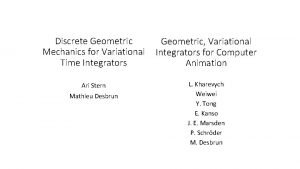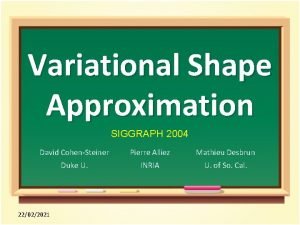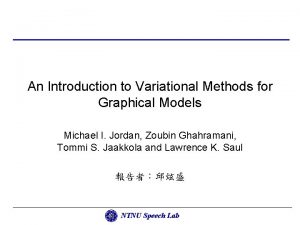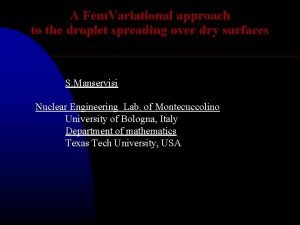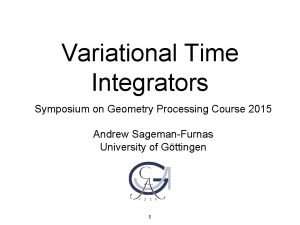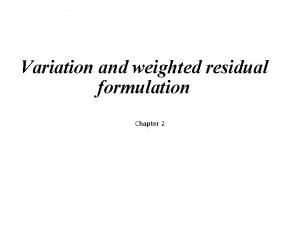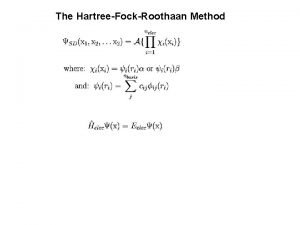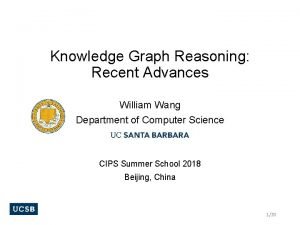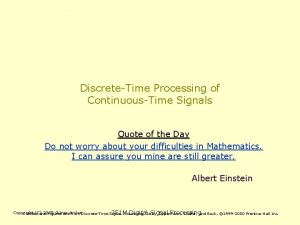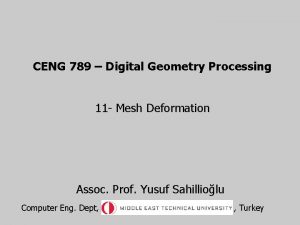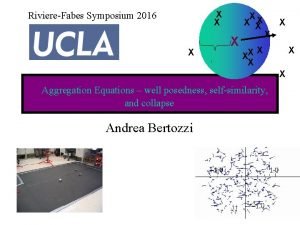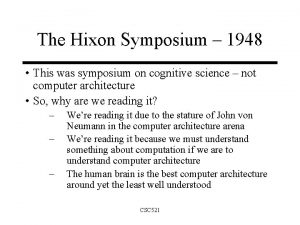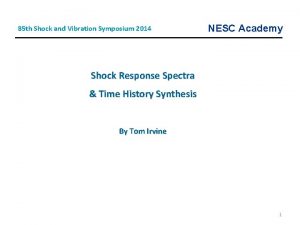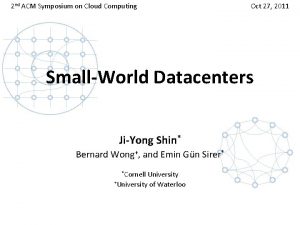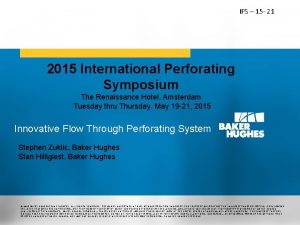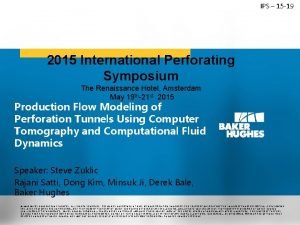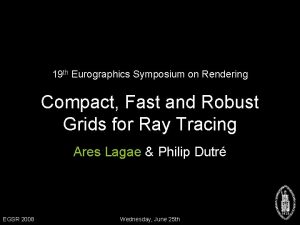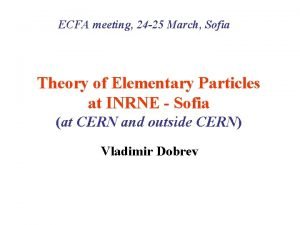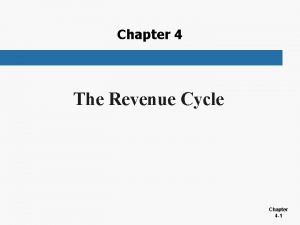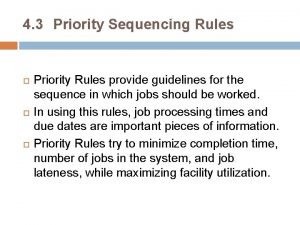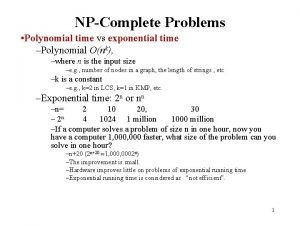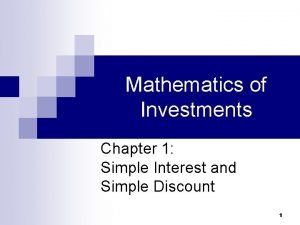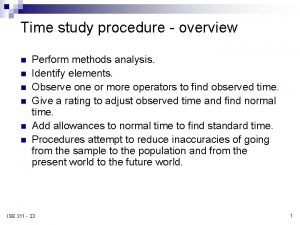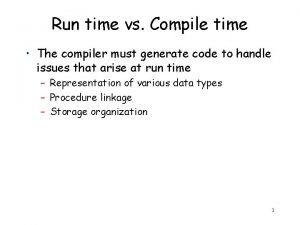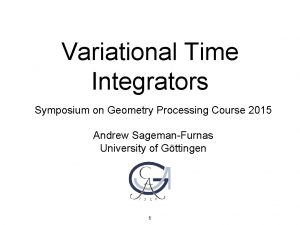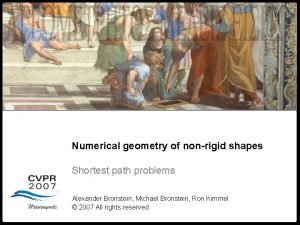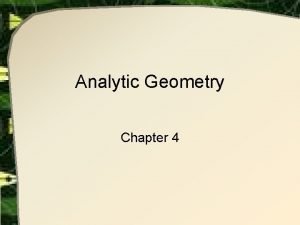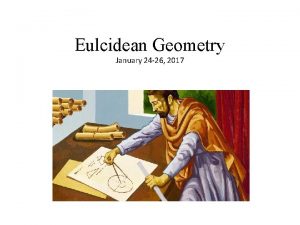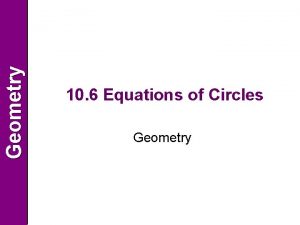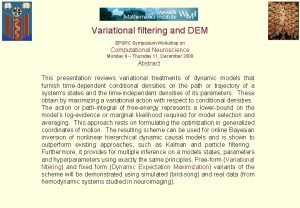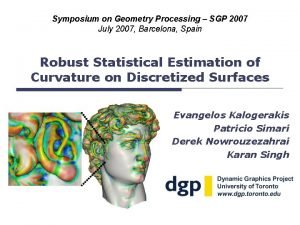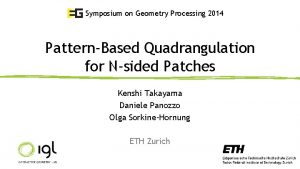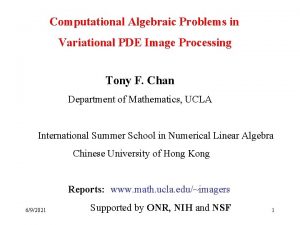Variational Time Integrators Symposium on Geometry Processing Course







































































































- Slides: 103

Variational Time Integrators Symposium on Geometry Processing Course 2015 Andrew Sageman-Furnas University of Göttingen 1

Time Integrator Differential equations in time describe physical paths Solve for these paths on the computer Non-damped, Non-Driven Pendulum 2

Methods of Time Integration Non-damped, Non-Driven Pendulum Explicit “artificial driving” Variational “reasonable” 3 Implicit “artificial damping”

Part One: Reinterpreting Newtonian Mechanics (what does “variational” mean? ) Part Two: Why Use Variational Integrators? 4

A Butchering of Feynman’s Lecture http: //www. nobelprize. org/nobel_prizes/physics/laureates/1965/feynman-bio. html Principle of Least Action (Feynman Lectures on Physics Volume II. 19) 5

Newtonian Mechanics Closed mechanical system Kinetic energy Potential energy Total energy 6

Newtonian Mechanics A physical path satisfies the vector equation Worked out using force balancing Difficult to compute with Cartesian coordinates 7

Lagrangian Reformulation Goal: Derive Newton’s equations from a scalar equation Why? Works in every choice of coordinates Highlights variational structure of mechanics Energy is easy to write down 8

Particle in a Gravitational Field B A “Throw a ball in the air from ( 9 , A) catch at ( , B)”

Particle in a Gravitational Field B A What path does the ball take to get from A to B in a given amount of time? 10

Particle in a Gravitational Field B A Physical path is unique and a parabola 11

Particle in a Gravitational Field B A . . . but there are many possible paths 12

Particle in a Gravitational Field B A How are physical paths special among all paths from A to B? 13

Hamilton’s Principle of Stationary Action Physical paths are extremal amongst all paths from A to B of a time integral called the action. 14

Hamilton’s Principle of Stationary Action Physical paths are extrema of a time integral called the action Lagrangian (Lagrangian is not the total energy 15 )

Hamilton’s Principle of Stationary Action Physical paths extremize the action . . . but how we find an extremal path in the space of all paths? Use Lagrange’s variational calculus 16

Finding an Extremal Path 1. Action of path 2. Differentiate action 3. Study when Analogous to regular calculus 17

Defining the Variation of an Action Arbitrary smooth offset Perturbed curve Curves share endpoints 18

Defining the Variation of an Action First Variation of the Action (in direction eta) Reduce to single variable calculus! 19

Defining the Variation of an Action First Variation of the Action (in direction eta) Differentiating a given path with respect to all smooth variations reduces to single variable calculus. Reduce to single variable calculus! 20

Particle Example: Setup 21

Particle Example: Investigating the Variation 22

Variational Trick: Essential Integration by Parts get rid of derivates of the offset recall offset vanishes at endpoints 23

Variational Trick: Essential Integration by Parts Integrate by parts to get rid of the derivatives of the smooth offset. This requires the offset to vanish at the boundary. 24

Particle Example: Investigating the Variation When is for all offsets 25

Fundamental Lemma of Variational Calculus For a continuous function if for all smooth functions then with vanishes everywhere in the interval. . believable, but why? 26 ,

Fundamental Lemma of Variational Calculus If then for all offsets vanishes on the interval. Assume 27 zero at

Fundamental Lemma of Variational Calculus If then for all offsets vanishes on the interval. 28 zero at

Fundamental Lemma of Variational Calculus If then for all offsets vanishes on the interval. 29 zero at

Fundamental Lemma of Variational Calculus If then for all offsets vanishes on the interval. 30 zero at

Fundamental Lemma of Variational Calculus If then for all offsets vanishes on the interval. 31 zero at

Fundamental Lemma of Variational Calculus If then for all offsets vanishes on the interval. 32 zero at

Fundamental Lemma of Variational Calculus If then for all offsets vanishes on the interval. must be zero where 33 zero at is nonzero

Fundamental Lemma of Variational Calculus If then for all offsets vanishes on the interval. must hold for every choice of 34 zero at

Fundamental Lemma of Variational Calculus If then So for all offsets vanishes on the interval. zero at vanishes everywhere in the interval. 35

Particle Example: Deriving Euler-Lagrange Equations Where we? When is for all offsets 36

Particle Example: Deriving Euler-Lagrange Equations Apply Fundamental Lemma Euler-Lagrange equations 37

Particle Example: Deriving Euler-Lagrange Equations Apply the Fundamental Lemma to see when the derivative vanishes Apply Fundamental Lemma and recover the Euler-Lagrange equations. Euler-Lagrange Equations 38

Particle Example: Lagrangian Reformulation Euler-Lagrange equations Wait. . . this looks familiar! is Newton’s law (reinserting mass) (force is derivative of potential energy) 39

Lagrangian Reformulation Summary Principle of Stationary Action A path connecting two points is a physical path precisely when the first derivative of the action is zero. Lagrangian Action Euler-Lagrange Equations 40 Fundament al Lemma

(general) Principle of Stationary Action “Variational principles” apply to many systems, e. g. , special relativity, quantum mechanics, geodesics, etc. Key is to find Lagrangian Fundament al Lemma so general Euler-Lagrange equations are the equations of interest 41

(general) Principle of Stationary Action “Variational principles” apply to many systems, e. g. , special relativity, quantum mechanics, geodesics, etc. The Euler-Lagrange equations for a Key is to find Lagrangian general Lagrangian are Fundament al Lemma so general Euler-Lagrange equations are the equations of interest 42

Noether’s Theorem Continuous symmetries of the Lagrangian imply conservation laws for the physical system. Continuous Symmetry Conserved Quantity Translational Linear momentum Rotational (one dimensional) Angular momentum Time Total energy 43

momentum (mass x velocity) Lagrangian Paths are Symplectic energ y levels position 44

Lagrangian Paths are Symplectic momentum (mass x velocity) Image from Hairer, Lubich, and Wanner 2006 energ y levels position in 2 D equivalent to area conservation in phase space (in higher dimensions implies volume conservation) 45

Discrete Hamilton’s Principle Variational Time Integrators Discretize Lagrangian Apply Variational Principle Arrive at Discrete Equations of Motion (as opposed to discretizing equations directly) 46

Discrete Noether’s Theorem Discretize Lagrangian Arrive at Discrete Equations of Motion Continuous symmetries of the discrete Lagrangian imply conserved quantities throughout entire discrete motion. (for not too large time steps) 47

Discrete Variational Integrators are Symplectic. . . time is now discrete, so total energy is not conserved. But, discrete symplectic structure guarantees bounded oscillation around true energy level energy (for not too large time steps) true conserved energy time 48

LUNCH BREAK 49 image from openclipart. org

Part Two: Why Use Variational Integrators? 50

Quick Recap Physical paths are extremal amongst all paths from A to B of the action integral B A Action is the integral of the Lagrangian, kinetic minus potential energy Symmetries of Lagrangian and symplectic structure give rise to conservation laws 51

Discrete Hamilton’s Principle Variational Time Integrators Discretize Action (integral of Lagrangian) Apply Variational Principle Arrive at Discrete Equations of Motion (as opposed to discretizing equations directly) 52

Discrete Noether’s Theorem Discretize Lagrangian Arrive at Discrete Equations of Motion Continuous symmetries of discrete Lagrangian imply conserved quantities throughout entire discrete motion, e. g. , conservation of linear and angular momentum (for not too large time steps) 53

Discrete Variational Integrators are Symplectic. . . time is now discrete, so total energy is not conserved. But, discrete symplectic structure guarantees bounded oscillation around true energy level energy (for not too large time steps) true conserved energy time 54

Discrete Variational Integrators are Symplectic. . . time is now discrete, so total energy is not conserved. But, discrete symplectic structure guarantees bounded oscillation around true energy level energy (for not too large time steps) Variational integrators are symplectic and vice versa. Both equivalent terms are used. true conserved energy time 55

Building a Variational Time Integrator 1. Choose a finite difference scheme , e. g. , forward backward central 2. Choose a quadrature rule to integrate action, e. g. , rectangular 3. Apply variational principle midpoint 56 trapezoid

Discrete Variational Principle Example forward rectangular 57

Discrete Variational Principle Example forward Choose a finite difference scheme and quadrature rule and write down the discrete rectangular action sum. 58

Discrete Variational Principle Example 59

Discrete Variational Principle Example get rid of derivates of the offset Summation by Parts recall offset vanishes at boundary 60

Discrete Variational Principle Example shift index 61

Discrete Variational Principle Example (discrete) Fundamental Lemma of Calculus of Variation discrete Euler-Lagrange Recall: 62

Discrete Variational Integrator Scheme forward Symplectic (variational) Euler 63

Discrete Variational Integrator Scheme discrete Euler-Lagrange Use and forward (left)Euler rectangular Semi-implicit Symplectic Euler Method A 64

Discrete Variational Integrator Scheme discrete Euler-Lagrange Use and backward (left)Euler rectangular Semi-implicit Symplectic Euler Method B 65

Time Integration Schemes Great. . . we know how to derive a variational integrator, but what other integrators are there? Where do they come from? Why are they used? How do they compare? 66

First Order Integration Schemes Explicit Euler Use (forward) first order Taylor approximation of motion 67

First Order Integration Schemes Explicit Euler use Newton’s law 68

First Order Integration Schemes Explicit Euler Cheap to compute -- explicit dependence of variables but adds artificial driving “unstable” for large time steps (drastically deviates from true trajectories) 69

Explicit Euler step size in seconds 70

Explicit: Time Step Refinement step size in seconds 71

First Order Integration Schemes Explicit (forward) Euler Implicit (backward) Euler motion “implicitly” depends on variables 72

First Order Integration Schemes Implicit Euler “stable” for large time steps (stays close to true trajectories) but adds artificial damping more expensive -- nonlinear solve for implicit variables 73

Implicit Euler step size in seconds 74

Implicit: Time Step Refinement step size in seconds 75

First Order Integration Schemes Symplectic Euler Method A Symplectic Euler Method B also called “semi-implicit” Euler methods 76

First Order Integration Schemes Symplectic Euler Methods, e. g. , as cheap as Explicit Euler bounded energy oscillation (little artificial damping/driving) conserved linear and angular momentum also unstable for very large time steps 77

Symplectic Euler (Method B) step size in seconds 78

Symplectic: Time Step Refinement step size in seconds 79

momentum (mass x velocity) Phase Space (energy levels) implicit symplectic explicit position 80

Energy Landscape Under Step Refinement explicit symplectic true energy implicit 81

Energy Landscape Near Time Zero explicit symplectic true energy implicit 82

Very Small Time Step explicit symplectic 83 implicit

Large Time Steps: Symplectic vs Implicit Sym Imp Symplectic unstable region shown in largest time step Implicit is stable, but damping is time step dependent 84

Three Integrators Summary Explicit Variational Implicit cheap artificial driving good energy more expensive artificial damping stable unstable for large momenta conserved 85

Three Integrators Summary Variational Integrators cheap good energy momenta conserved Explicit cheap Implicit good energy artificial damping but (can’tcheap have it all!)more expensive artificial driving unstable Variational unstable for large momenta conserved 86 stable

Damped Systems Want to include non-conservative forces, too Systems with non-conservative forces satisfy the Lagrange-D’Alembert Principle integral of force variation of action in direction of in direction eta variation, eta modification of Principle of Stationary Action 87

Damped Systems Lagrange-D’Alembert Principle Discretize using Variational Principle with: forward rectangular (Forced Symplectic Euler Method) 88

Discrete Lagrange-D’Alembert Principle Forced Symplectic Euler Method B e. g. , air resistance 89

Variational Damped Pendulum 30% damped non-damped behavior independent of step size (within stable region) 90

Variational Damped Pendulum non-damped 80% damped 30% damped behavior independent of step size (within stable region) 91

30% Damped Pendulum Variational step size independe nt Implicit step size dependen t 92

30% Damped Pendulum Forced Variational Integrators Variational step size independen t cheap good energy behavior independent of step size (in stable region) Implicit Essential for rough previews step size often done in Computer dependent Graphics 93

Higher Order Variational Integrators Recall: zeroth order quadrature forward rectangular yields first order integration scheme Generically: order quadrature yields order integrator 94

Higher Order Variational Integrators Recall: zeroth order Variational Integrators quadrature forward exist of all orders rectangular order quadrature yields first order integration scheme order integrator Generically: order quadrature yields order integrator 95

Some Well Known Variational Integrators (of second order) Use: forward trapezoid Derive: Störmer-Verlet Method 96

Some Well Known Variational Integrators (of second order) Use: forward midpoint Derive: Implicit Midpoint Method (algebraic miracle, zeroth yields second order) 97

Comparison of First and Second Order Integrators Image from Hairer, Lubich, and Wanner 2006 98

Summary: Variational Time Integrators No more difficult to implement. . . but have many advantages. . . 99

Summary: Variational Time Integrators Discrete Principle of Stationary Action Noether’s theorem guarantees conservation of momenta Forced systems have behavior independent of step size (for stable time steps) 100 energ y Symplectic structure guarantees good energy behavior time

Questions? 101

(very incomplete list of) further reading Principle of Least Action Feynman Lectures on Physics II. 19 http: //www. feynmanlectures. caltech. edu/II_19. html Geometric Numerical Integration: Structure-preserving Algorithms for Ordinary Differential Equations. Hairer E, Lubich C, Wanner G. Springer; 2002. Variational integrators. West, Matthew (2004) Dissertation (Ph. D. ), California Institute of Technology. Geometric, variational integrators for computer animation. L. Kharevych, Weiwei Yang, Y. Tong, E. Kanso, J. E. Marsden, P. Schröder, and M. Desbrun. 2006. In Proceedings of the 2006 ACM SIGGRAPH/Eurographics symposium on Computer animation (SCA '06). Speculative parallel asynchronous contact mechanics. Samantha Ainsley, Etienne Vouga, Eitan Grinspun, and Rasmus Tamstorf. 2012. ACM Trans. Graph. 31, 6, Article 151 (November 2012), 8 pages. DOI=10. 1145/2366145. 2366170 102

Details of Movies Shown Pendulum assumptions: mass equals length equals one initial conditions movies at 16 fps 103
 Iiot integrators
Iiot integrators Ibm systems integrator
Ibm systems integrator Discrete integrators
Discrete integrators Automation integrators
Automation integrators Variational shape approximation
Variational shape approximation An introduction to variational methods for graphical models
An introduction to variational methods for graphical models Variational message passing
Variational message passing Variational methods
Variational methods Variational approach in fem
Variational approach in fem Variational calculus
Variational calculus Weighted residual method
Weighted residual method Hamiltonian operator
Hamiltonian operator Variational knowledge graph reasoning
Variational knowledge graph reasoning Discrete time processing of continuous time signals
Discrete time processing of continuous time signals Theory of structures
Theory of structures Electron domain geometry vs molecular geometry
Electron domain geometry vs molecular geometry Molecular geometry and bonding theories
Molecular geometry and bonding theories Digital geometry processing
Digital geometry processing Geometric transformation in digital image processing
Geometric transformation in digital image processing Image geometry in digital image processing
Image geometry in digital image processing Header bond t junction
Header bond t junction Course title and course number
Course title and course number Course interne moyenne externe
Course interne moyenne externe Example of elapsed time
Example of elapsed time Intel netbatch
Intel netbatch Top-down processing vs bottom-up processing
Top-down processing vs bottom-up processing Gloria suarez
Gloria suarez Bottom-up processing examples
Bottom-up processing examples Unsharp masking matlab
Unsharp masking matlab What is secondary processing of food
What is secondary processing of food Define point processing
Define point processing Histogram processing in digital image processing
Histogram processing in digital image processing Parallel processing vs concurrent processing
Parallel processing vs concurrent processing Laplacian filter
Laplacian filter What is point processing in digital image processing
What is point processing in digital image processing Digital image processing
Digital image processing Bottom down processing
Bottom down processing Interactive processing
Interactive processing Riviere fabes symposium
Riviere fabes symposium Hixon symposium
Hixon symposium Disadvantages of symposium
Disadvantages of symposium International police executive symposium
International police executive symposium Texas suicide prevention symposium
Texas suicide prevention symposium Denver metro speech language symposium
Denver metro speech language symposium Equally well symposium
Equally well symposium Shock and vibration symposium
Shock and vibration symposium Question about family symposium
Question about family symposium Myanmar restaurant berlin
Myanmar restaurant berlin Epiko in greek
Epiko in greek Lean symposium
Lean symposium Ciarb mediation symposium
Ciarb mediation symposium Florida hazmat symposium
Florida hazmat symposium Acm symposium on cloud computing
Acm symposium on cloud computing Symposium
Symposium Objectives of symposium
Objectives of symposium Banking analytics symposium
Banking analytics symposium International perforating symposium
International perforating symposium International perforating symposium
International perforating symposium Ips perforating
Ips perforating Ips perforating
Ips perforating International perforating symposium
International perforating symposium Symposium
Symposium Geo virtual symposium
Geo virtual symposium International perforating symposium
International perforating symposium Eurographics symposium on rendering
Eurographics symposium on rendering Ecfa symposium
Ecfa symposium Csi bible symposium
Csi bible symposium Slag valorisation symposium 2021
Slag valorisation symposium 2021 Vwog
Vwog University of southern california
University of southern california Title iii symposium
Title iii symposium Title iii symposium
Title iii symposium International symposium on molecular spectroscopy
International symposium on molecular spectroscopy Meaning:symposium
Meaning:symposium Sachkontenrahmen
Sachkontenrahmen Vsv symposium
Vsv symposium Shock and vibration symposium
Shock and vibration symposium Ny metro asc symposium new york
Ny metro asc symposium new york Ncsu undergraduate research symposium
Ncsu undergraduate research symposium Time tracking course
Time tracking course Revenue cycle document flowchart
Revenue cycle document flowchart Importance of order cycle
Importance of order cycle Explain priority sequencing
Explain priority sequencing Test system architecture
Test system architecture Nfpa 1061 certifications
Nfpa 1061 certifications Takt time vs cycle time
Takt time vs cycle time Lead time bias vs length time bias
Lead time bias vs length time bias Length bias vs lead time bias
Length bias vs lead time bias Polynomial time vs exponential time
Polynomial time vs exponential time Military time
Military time I think i was about at the time
I think i was about at the time Lead time bias vs length time bias
Lead time bias vs length time bias Setup time and hold time in digital electronics
Setup time and hold time in digital electronics On time off time dorothea tanning
On time off time dorothea tanning 12 hour clock to 24
12 hour clock to 24 How to find rate of simple interest
How to find rate of simple interest Comparing distance/time graphs to speed/time graphs
Comparing distance/time graphs to speed/time graphs Calculating iv infusion rate
Calculating iv infusion rate Once upon a time and long ago
Once upon a time and long ago Seek time
Seek time Techniques of work study
Techniques of work study Time study procedure
Time study procedure Sixty percent of the time it works every time
Sixty percent of the time it works every time Compile time vs run time
Compile time vs run time


